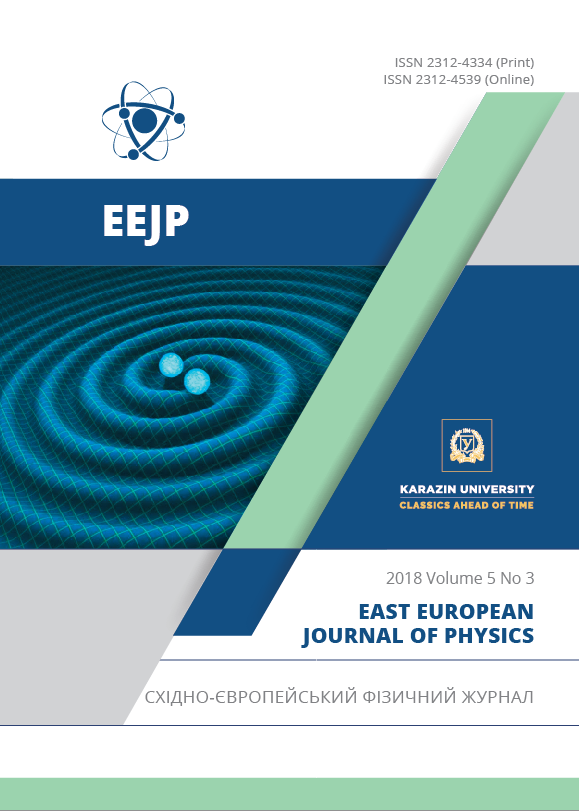Electrolytic Plasma Polishing of Copper
Abstract
Modern industrial technological processes require special preparation of metal surfaces. Currently, there are different methods of surface treatment of metal. Among them, it is possible to distinguish the method of electrolytic-plasma polishing (PEP– plasma electrolytic polishing) is distinguished as an innovative, due to its ecological properties, low energy consumption per unit of surface to be processed, high speed of modification and the possibility of processing parts of complex geometric shape. The main advantage of this method of surface modification is its ecological purity, which makes it possible to apply this technology to the food and pharmaceutical industry. Despite the large number of journal publications, electrolytic plasma polishing remains an innovative surface modification method that needs to be thoroughly studied in order to improve understanding of physical processes and optimize the surface modification process. The process of obtaining electrolytic plasma polishing of copper products in a solution of ammonium sulfate with the addition of sulfuric acid is considered in the paper. The experiment was divided into two stages. At first, the samples were treated for 600 seconds each for the obtain of temperature characteristics, with a strong correlation between the load current and the electrolyte temperature was observed. Dependence of the current on the temperature of the electrolyte showed four different modes of treatment. One of the modes showed the best results. During the second series of experiments, the processing of objects from 30 to 600 seconds. As a result of the conducted studies, optimal regimes for polishing copper objects were obtained.
Downloads
References
Sung Chul Cha, Ali Erdemir. Coating Technology for Vehicle Applications. – Cham: Springer International Publishing, 2015. – 240 p.
Garber M.I. Dekorativnoeshlifovanie i polirovanie, 2-e, dop. i pererabot. ed [Decorative grinding and polishing]. – Moskva: Mashinostroyenie, 1964. - P.192. (In Russian)
Yerokhin A.L., Nie X., Leyland A., Matthewsand A., Dowey S.J. Plasma electrolysis for surface engineering // Surface and Coatings Technology. – 1999. – No. 122. - P. 73-93.
Pogrebniak A.D., Tiurin Iu.N., Boiko A.G., Zhadkevich M.L., Kalyshkanovand M.K., Ruzimov Sh.M., Elektrolitno-plazmennaiaobrabotka i naneseniepokrytii na metally i splavy [Electrolyte-plasma processing and coating on metals and alloys] // Uspekhifiz. Met. – 2005. – Vol. 6. – P. 273-344.
Gupta P., Tenhundfeld G., Daigleand E.O., Ryabkov D., Electrolyticplasmatechnology: Science and engineering —Anoverview // Surface&Coatings Technology. – 2007. – No. 201. – P. 8746-8760.
Parfenov E.V., Yerokhin A., Nevyantseva R.R., Gorbatkov M.V., Liangand C.-J., Matthews A., Towards Smart Electrolytic Plasma Technologies: An Overview of Methodological Approaches to Process Modelling // Surface&Coatings Technology. – 2015.
Ushomirskaia L.A., Gerasimov A.S. Tekhnologicheskie vozmozhnjsti primeneniia struinogo techeniia elektrolita pri elektrolitno-plazmennom polirovanii [Technological possibilities of application of a jet stream of electrolyte at electrolytic plasma polishing] // Metalloobrabotka. – 2015. – No. 4. – P. 25-30.
Nestler K., Böttger-Hiller F., Adamitzki W., Glowa G., Zeidlerand H., Schubert A. Plasma Electrolytic Polishing – an Overview of Applied Technologies and Current Challenges to Extend the Polishable Material Range // Procedia CIRP. – 2016. – No. 42. - P. 503 – 507.
Rashid M. H. Power electronics handbook, Elseviered., Ed., Oxford, UK: Elsevier, 2011. – 1409 p.
BS EN ISO 4287:2000, Geometrical product specification (GPS). Surface texture. Profile method. Terms, definitions and surface texture parameters.
Authors who publish with this journal agree to the following terms:
- Authors retain copyright and grant the journal right of first publication with the work simultaneously licensed under a Creative Commons Attribution License that allows others to share the work with an acknowledgment of the work's authorship and initial publication in this journal.
- Authors are able to enter into separate, additional contractual arrangements for the non-exclusive distribution of the journal's published version of the work (e.g., post it to an institutional repository or publish it in a book), with an acknowledgment of its initial publication in this journal.
- Authors are permitted and encouraged to post their work online (e.g., in institutional repositories or on their website) prior to and during the submission process, as it can lead to productive exchanges, as well as earlier and greater citation of published work (See The Effect of Open Access).








